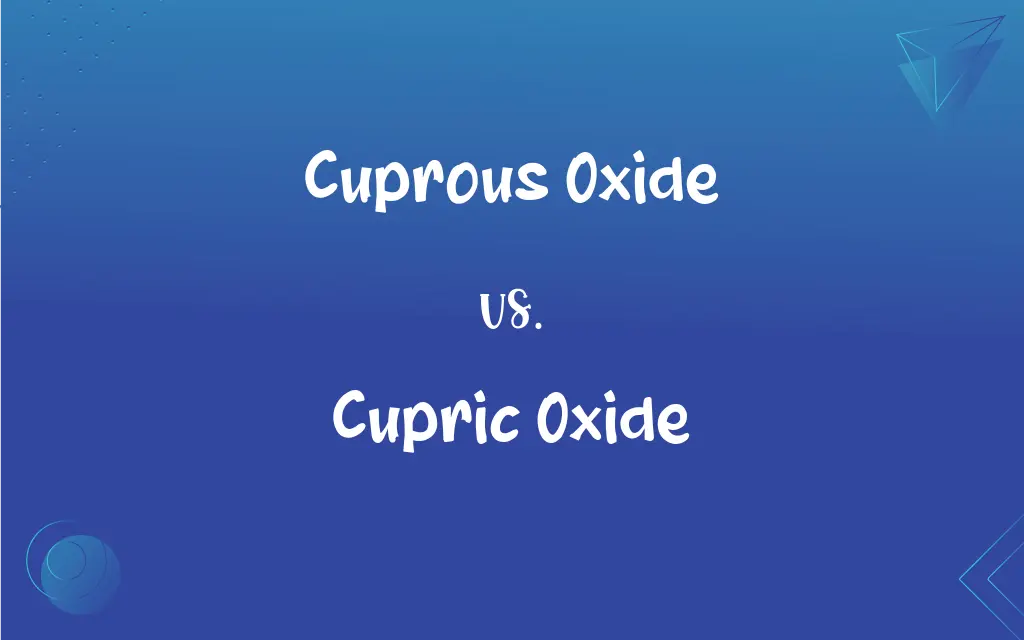Cuprous Oxide vs. Cupric Oxide: What's the Difference?
Edited by Aimie Carlson || By Harlon Moss || Published on December 13, 2023
Cuprous oxide (Cu2O) is a red oxide of copper with a +1 oxidation state, while cupric oxide (CuO) is a black oxide of copper with a +2 oxidation state.

Key Differences
Cuprous oxide is characterized by its red color and is copper(I) oxide, where copper has a +1 oxidation state. In contrast, cupric oxide is black and is copper(II) oxide, with copper in a +2 oxidation state. Both are compounds of copper and oxygen but differ in their copper oxidation states.
In cuprous oxide, each copper atom pairs with one oxygen atom, forming a lattice structure. Cupric oxide, on the other hand, features a different structure where each copper atom is bonded to two oxygen atoms. This structural difference is due to the varying oxidation states of copper in each oxide.
Cuprous oxide is less common and less stable than cupric oxide. It tends to oxidize further into cupric oxide upon exposure to air over time. Cupric oxide is more stable and widely used in various industrial applications.
In terms of applications, cuprous oxide is used in antifouling paints and as a fungicide. Cupric oxide, however, finds broader usage in ceramics, batteries, and as a pigment.
On the molecular level, the formula for cuprous oxide is Cu2O, indicating the presence of two copper atoms for every oxygen atom. In contrast, cupric oxide has the formula CuO, showing a one-to-one ratio of copper to oxygen.
ADVERTISEMENT
Comparison Chart
Color
Red
Black
Oxidation State
+1
+2
Copper to Oxygen Ratio
2:1
1:1
Stability
Less stable
More stable
Common Uses
Antifouling paints, fungicides
Ceramics, batteries, pigments
ADVERTISEMENT
Cuprous Oxide and Cupric Oxide Definitions
Cuprous Oxide
A red oxide of copper with a +1 oxidation state.
Cuprous oxide is used in marine paints to prevent barnacle growth.
Cupric Oxide
More stable and common than cuprous oxide.
In industrial settings, cupric oxide is preferred for its stability.
Cuprous Oxide
A less stable form of copper oxide that can further oxidize.
The cuprous oxide sample turned black as it oxidized to cupric oxide.
Cupric Oxide
A black oxide of copper with a +2 oxidation state.
Cupric oxide is often used as a pigment due to its black color.
Cuprous Oxide
Has a distinct red color, differentiating it from cupric oxide.
The red pigment in the paint was identified as cuprous oxide.
Cupric Oxide
Used in batteries, ceramics, and as a pigment.
The battery's electrodes contained cupric oxide.
Cuprous Oxide
Used in fungicides and antifouling applications.
The garden fungicide contains cuprous oxide as an active ingredient.
Cupric Oxide
Copper(II) oxide, a compound with a 1:1 copper to oxygen ratio.
Cupric oxide was added to the ceramic glaze for color.
Cuprous Oxide
Copper(I) oxide, a compound with a 2:1 copper to oxygen ratio.
In the lab, we synthesized cuprous oxide for our experiment.
Cupric Oxide
Known for its black color, distinguishing it from cuprous oxide.
The black crystals were identified as cupric oxide.
FAQs
What is Cuprous Oxide?
Cuprous Oxide (Cu2O) is a red or reddish-brown solid compound of copper and oxygen, where copper is in a +1 oxidation state.
What are the uses of Cuprous Oxide?
It's used in antifouling paints for boats, as a fungicide, and in making red glass and ceramics.
What is Cupric Oxide?
Cupric Oxide (CuO) is a black solid compound where copper is in a +2 oxidation state.
What are the uses of Cupric Oxide?
Cupric Oxide is used in producing copper salts, as a pigment, and in batteries.
What is the color of Cupric Oxide?
Cupric Oxide is usually black.
Is Cupric Oxide soluble in water?
Cupric Oxide is also insoluble in water.
How is Cuprous Oxide formed?
Cuprous Oxide forms by the controlled oxidation of copper metal or reduction of cupric salts.
What is the color of Cuprous Oxide?
Cuprous Oxide is typically red or reddish-brown.
How are Cuprous Oxide and Cupric Oxide chemically different?
The key difference lies in their copper oxidation states; cuprous has copper in +1, while cupric has copper in +2.
Are there any health risks associated with Cuprous Oxide?
Yes, excessive exposure can lead to respiratory and skin irritation, and it's toxic if ingested.
How is Cupric Oxide formed?
Cupric Oxide is typically formed by the oxidation of copper in air at high temperatures.
What is the molecular weight of Cuprous Oxide?
The molecular weight of Cuprous Oxide (Cu2O) is about 143.09 g/mol.
How do the electrical properties of Cuprous Oxide and Cupric Oxide differ?
Cuprous Oxide is a semiconductor, whereas Cupric Oxide has more complex electrical properties, including semiconducting and antiferromagnetic behaviors.
Are there any health risks associated with Cupric Oxide?
Yes, like Cuprous Oxide, it can be irritating to skin and lungs and is toxic if ingested.
What is the molecular weight of Cupric Oxide?
The molecular weight of Cupric Oxide (CuO) is approximately 79.55 g/mol.
What is the significance of Cuprous Oxide in semiconductor technology?
Cuprous Oxide has been used in the production of solar cells and photovoltaic cells due to its semiconductor properties.
Is Cuprous Oxide soluble in water?
No, Cuprous Oxide is insoluble in water.
Can Cuprous Oxide be converted to Cupric Oxide?
Yes, further oxidation of Cuprous Oxide can lead to the formation of Cupric Oxide.
Is Cuprous Oxide a natural mineral?
Yes, it naturally occurs as the mineral cuprite.
Is Cupric Oxide a natural mineral?
Yes, it occurs as the mineral tenorite.
About Author
Written by
Harlon MossHarlon is a seasoned quality moderator and accomplished content writer for Difference Wiki. An alumnus of the prestigious University of California, he earned his degree in Computer Science. Leveraging his academic background, Harlon brings a meticulous and informed perspective to his work, ensuring content accuracy and excellence.
Edited by
Aimie CarlsonAimie Carlson, holding a master's degree in English literature, is a fervent English language enthusiast. She lends her writing talents to Difference Wiki, a prominent website that specializes in comparisons, offering readers insightful analyses that both captivate and inform.






































































